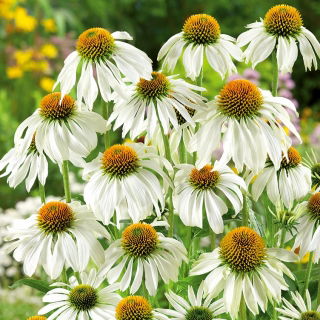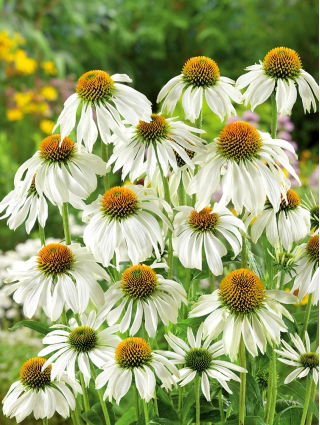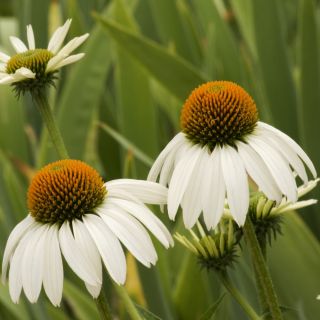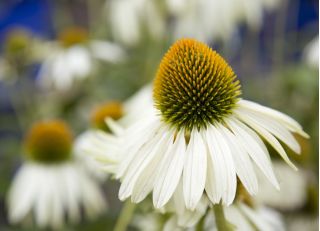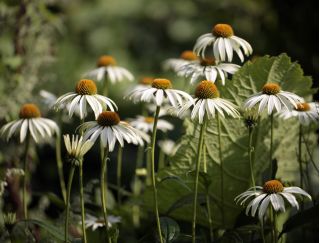Echinacea 'White Swan' is a remarkable plant that brings elegance and subtle charm to your garden. Its striking white blooms, perched on sturdy stems, make an excellent addition to perennial borders and naturalistic garden designs. Its nectar-rich nature attracts bees and other beneficial insects, supporting biodiversity in your garden. 'White Swan' is appreciated not only for its aesthetic appeal but also for its versatility, including its use as a cut flower.
Sowing
Echinacea 'White Swan' seeds thrive best in moderate temperatures. Seeds can be sown directly in the ground or under cover, allowing for a speedy start to their vegetative growth.
Sowing Depth
The optimal sowing depth for Echinacea seeds is 1-1.5 cm. This depth provides the seeds with ideal conditions for germination and protection from adverse weather conditions.
Direct Sowing Period
When is the best time to sow Echinacea 'White Swan' seeds directly in the ground? It is recommended to sow in spring, which allows the plant to make full use of the growing season. It's best to choose a time when the soil has warmed sufficiently.
Sowing Period Under Cover
When to sow Echinacea 'White Swan' seeds under cover? Seeds can be sown under cover in spring, which permits an earlier start to their growth and prepares seedlings for later transplantation into the garden.
Planting Time
The ideal time for planting Echinacea is at the end of summer to autumn. This timing gives the plant enough time to establish its roots before winter arrives.
Plant Spacing
Echinacea 'White Swan' requires space to grow freely. A recommended spacing of 50x40 cm provides adequate air circulation and light access.
Companion Planting
Echinacea pairs well with other perennials that have similar requirements, such as Rudbeckia or Salvia. It creates harmonious compositions with ornamental grasses and plants with contrasting colours.
Site Conditions
Echinacea 'White Swan' prefers sunny positions, which encourage abundant flowering. The soil should be well-drained, moderately moist, and enriched with compost to support root development and plant growth. It tolerates occasional droughts well, making it ideal for gardens where regular watering isn't always possible.
Growing Tips
Echinacea 'White Swan' is an undemanding plant, making it a perfect choice for novice gardeners. It's beneficial to regularly remove spent flower heads to stimulate prolonged blooming. During dry periods, watering is advised, and a multi-component fertiliser in spring will support its growth.
Plant Height
Echinacea 'White Swan' reaches a height of 80-100 cm, making it an excellent background element in perennial borders. Its majestic form adds structure and elegance to the garden.
Flowering Period
Echinacea 'White Swan' blooms from June to August, providing a long period of decorative appeal. This allows you to enjoy its beauty throughout the summer.
Usage
Echinacea 'White Swan' is ideal for perennial borders, naturalistic plantings, and as a cut flower. Its blooms bring natural charm to interiors, and in the garden, they create beautiful compositions with other perennials.
Resistance to Diseases
Echinacea 'White Swan' is highly resistant to diseases, making it a reliable choice for any garden. It withstands variable weather conditions well and is rarely affected by pests.
Good to Know
Echinacea 'White Swan' is valued not only for its decorative qualities but also for its medicinal properties. It is often used in herbal medicine as a plant that boosts the immune system. It's worth knowing that it is easy to grow, and the plant quickly spreads, forming impressive clumps.
Why Buy from Garden Seeds Market
Purchasing seeds from Garden Seeds Market ensures the highest quality. The seeds undergo rigorous laboratory testing to guarantee high germination rates. The shop offers fast and secure delivery, expert advice, and attractive promotions for regular customers. Satisfied customer reviews confirm the shop's reliability and professionalism.
The seed packet contains 0,3 g of seeds. The packet includes information on cultivation guidelines and the sowing expiration date.

